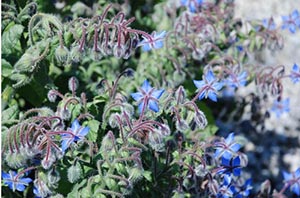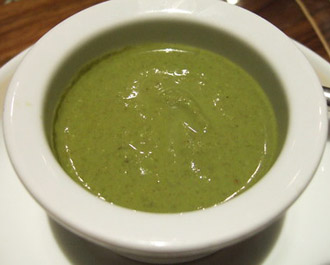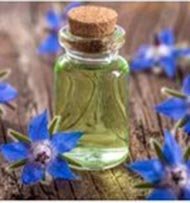Borage Nutrition facts
Borage, also known as the bee plant, is one of the chosen culinary herbs employed by grandmothers to prepare famous green sauces, garnish salads, or pamper children with candied flowers! This ancient garden herb exudes a characteristic "cucumber-like" aroma to the recipes. For the same reasons, it is one of the most sought-after herbs in Mediterranean households even today.
Botanically, it belongs to the family of Boraginaceae, of the genus, Borago and has the scientific name: Borago officinalis. The herb is also known as starflower since it bears five-petaled, deep-blue, beautiful star-shaped flowers in clusters. Some of the other common names include bee bread, Burrage, common-bugloss, etc.
 |
| Borage (Borago officinalis).
Note for large, oval dark green leaves with star-shaped deep-blue flowers. Photo courtesy: kthread |
Borage is an annual hollow-stemmed plant with bristly hairs on its surface. It reaches about 75-90 cm in height and grows plentiful all over the wild highlands of Eastern Europe and Asia Minor regions.
The plant features broad oval-shaped, dark green fuzzy leaves. In general, its leaves are gathered early, soon after the appearance of flower buds but before the opening of the flowers.
Young, tender leaves can also be used in salads, while mature leaves may be employed as greens. However, as the plant gets older, its leaves become tough, larger, fuzzier, and bitter in taste.
Health benefits of Borage
Borage is one of the favorite low-calorie culinary herbs found in use, especially in Mediterranean countries. 100 g of fresh leaves carry just 21 calories. The herb contains many important phytonutrients, minerals, and vitamins that are essential for optimum health and wellness.
The herb contains essential fatty acid γ -linolenic acid (GLA), typically in concentrations of 17-20%. Linolenic acid is an omega-6 fatty acid that plays a vital role in the restoration of joint health, immunity, and healthy skin and mucosa.
Fresh borage herb has high levels of vitamin C (ascorbic acid); provides 35 mg or 60% of RDA per 100 g. Vitamin C is one of the powerful natural antioxidants that help remove harmful free radicals from the body. Together with other anti-oxidants, it has an immune booster, wound healing, and anti-viral effects.
Starflower herb is one of the rich sources of vitamin A (140% of RDA) and carotenes. Both these compounds are powerful flavonoid anti-oxidants. Together, they act as protective scavengers against oxygen-derived free radicals and reactive oxygen species (ROS) that play a vital role in aging and various disease processes.
Vitamin A is also known to have antioxidant properties and is essential for vision. It is also required for maintaining healthy mucosa and skin. Consumption of natural foods rich in vitamin A and carotenes is known to help the human body protect from lung and oral cavity cancers.
The herb holds a good amount of minerals like iron (41% of RDA), calcium, potassium, manganese, copper, zinc, and magnesium. Potassium is an important component of cell and body fluids, which helps control heart rate and blood pressure. Manganese is utilized as a co-factor for the antioxidant enzyme, superoxide dismutase. Iron is an essential co-factor for cytochrome oxidase which is a crucial enzyme in the cellular metabolism. Further, being a component of hemoglobin inside the red blood cells, iron determines the oxygen-carrying capacity of the blood.
Further, the herb is one of the moderate sources of B-complex vitamins, particularly rich in niacin (vitamin B-3). Niacin helps lower LDL cholesterol levels in the body. Also, it has riboflavin, thiamin, pyridoxine, and folates at average levels. These vitamins function as co-factors in the enzymatic metabolism inside the body.
| Principle | Nutrient Value | Percent of RDA |
|---|---|---|
| Energy | 21 Kcal | 1% |
| Carbohydrates | 3.06 g | 2.35% |
| Protein | 1.80 g | 3% |
| Total Fat | 0.70 g | 2% |
| Cholesterol | 0 mg | 0% |
| Vitamins | ||
| Folates | 13 µg | 3% |
| Niacin | 0.900 mg | 25.5% |
| Pantothenic acid | 0.041 mg | 1% |
| Pyridoxine | 0.084 mg | 6.5% |
| Riboflavin | 0.150 mg | 12% |
| Thiamin | 0.060 mg | 5% |
| Vitamin A | 4200 IU | 140% |
| Vitamin C | 35 mg | 60% |
| Electrolytes | ||
| Sodium | 80 mg | 5% |
| Potassium | 470 mg | 10% |
| Minerals | ||
| Calcium | 93 mg | 9% |
| Copper | 0.130 mg | 15% |
| Iron | 3.30 mg | 41% |
| Magnesium | 52 mg | 13% |
| Manganese | 0.349 mg | 15% |
| Zinc | 0.20 mg | 2% |
Selection and storage
Borage should be fresh for its use in salads and cooking. While buying from the markets, look for fresh herb leaves with stout, succulent stems and delicate cucumber flavor that can be appreciated from a short distance.
Much like other greens such as spinach, borage can stay fresh only for a few hours and lose its flavor sooner. Unlike in other herbs like oregano where dry herbs (leaves) and powder can be added to cuisine, dried borage leaves are out of flavor, and therefore, avoided.
Avoid sunken, yellow, or dried leaves as they are out of flavor.
Once at home, store borage, as you do it for spinach or any other greens.
Preparation and serving methods:
Wash fresh herbs in cold running water or rinse for a few minutes to remove any dirt or pesticide residues. The herb can be used in large quantities like other green vegetables. Remove tough leaves and stems using a paring knife.
Here are some cooking tips:
 |
| Mediterranean green sauce-salsa verde. Photo courtesy: toyohara |
Young tender borage leaves can add delicate cucumber flavor to the salads.
Mature but tender leaves can be employed as a green vegetable in much the same way as spinach. It mixes well with other greens, french beans, carrots, potato, tomato, etc.
Tender leaves used to make fresh juice with added lemonade.
Borage flowers are often mixed in batter and fried in oil to delicious fritters. They can also be candied.
Borage is one of the common ingredients along with parsley, chervil, chives, watercress, sorrel, and salad burnet in the preparation of traditional German green sauce.
Fresh herbs can also be added to sausages, pizza, and poultry stuffing.
Borage tea is a popular refreshing drink in European countries.
Medicinal uses of borage herb
 |
| Borage oil |
-
Borage herb parts, especially its seeds contain important health-benefiting essential oils such as gamma-linolenic acid. This omega-6 fatty acid (18:3 fats) is recommended in the treatment of arthritis, dermatitis, pre-menstrual painful conditions, etc.
- An infusion of leaves and seeds is used in traditional medicines to increase breast milk secretion in nursing mothers. (Medical disclaimer)
Safety profile
The borage herb contains certain compounds, which when taken in large quantities, may affect kidney functions (possible diuretic effect). (Medical disclaimer).
≻≻-Back to Herbs from Borage. Visit here for an impressive list of all varieties of herbs with complete illustrations of their nutrition facts and health benefits.
≻≻-Back to Home page.
Further Resources:
Starflower- antioxidants-B. officinalis L.